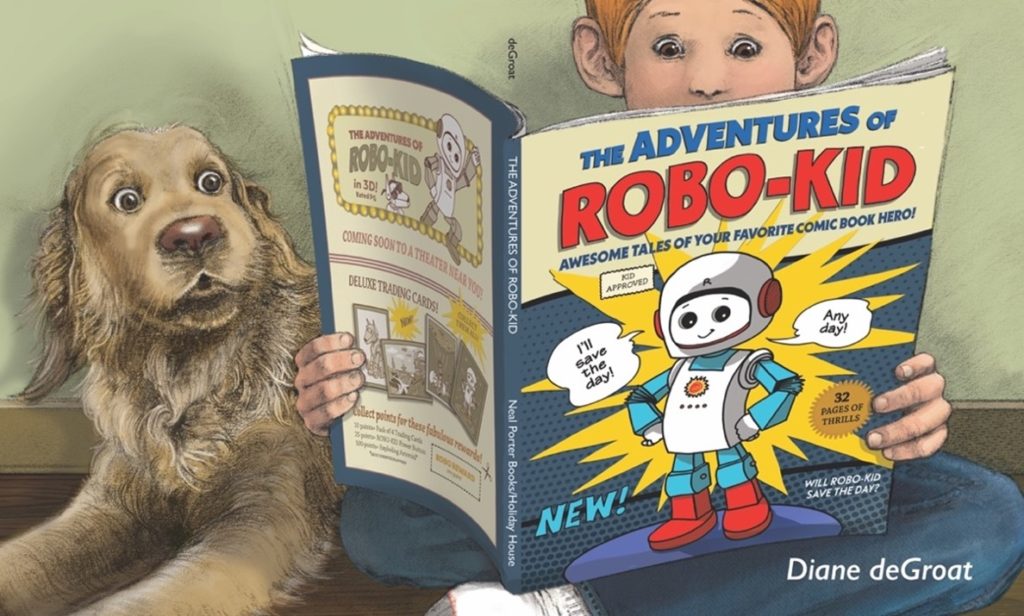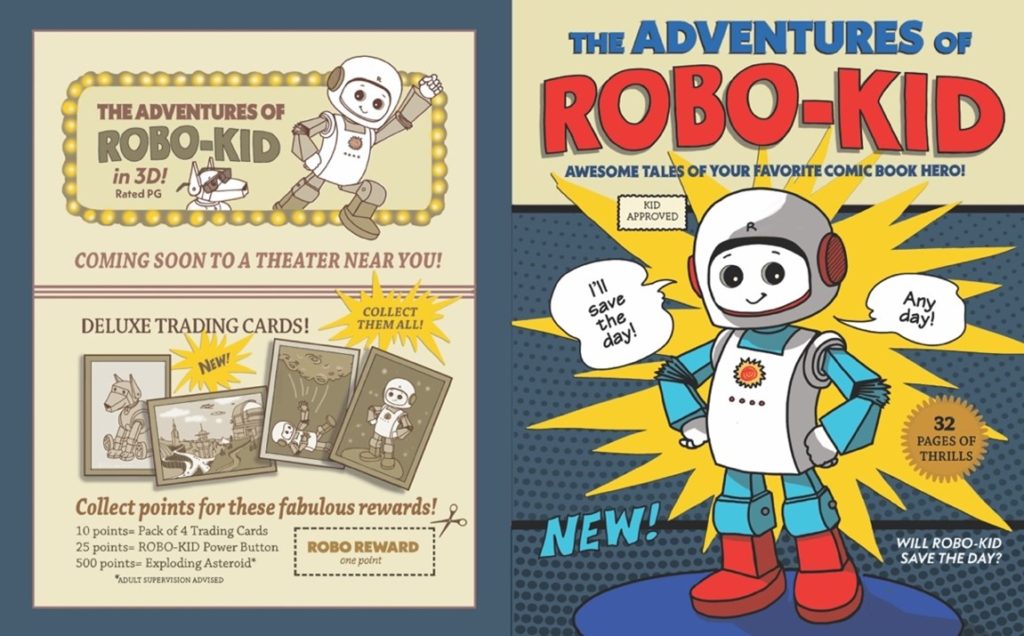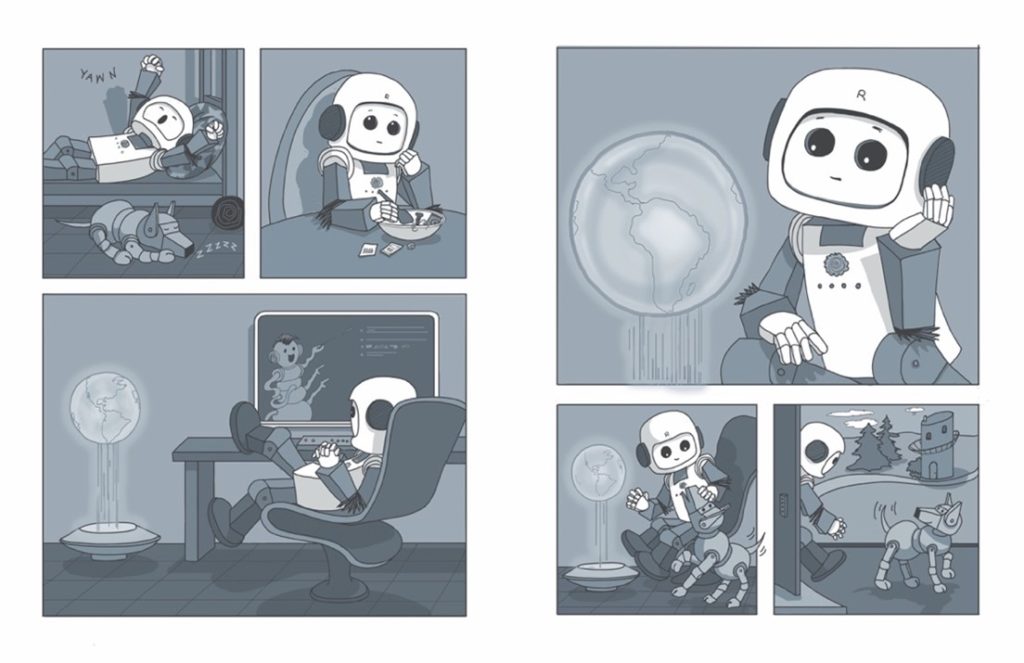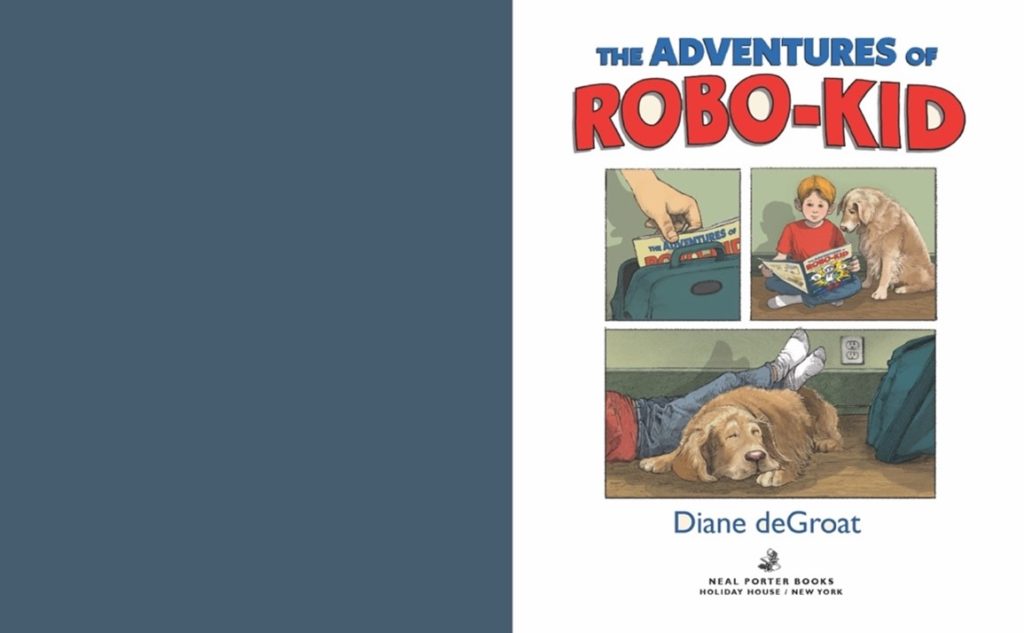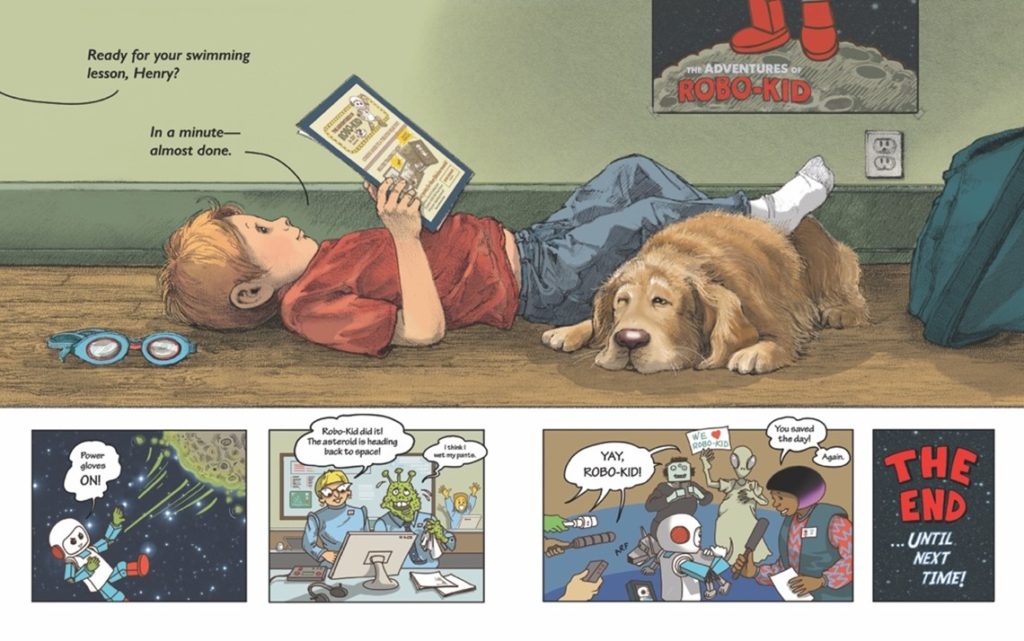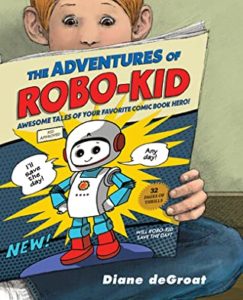“The Whole Book Approach to The Adventures of Robo-Kid”
The Whole Book Approach to story time reading was developed by Megan Dowd Lambert in association with the Eric Carle Museum of Picture Book Art to “bring children’s ideas and questions to the center of shared reading while celebrating the picture book as a visual form.” Yes, it’s a mouthful, but when witnessed in action, it becomes an exciting way to share picture books with children by drawing inspiration from Visual Thinking Strategies (www.vtshome.org). As Megan says in the preface to her book, Reading Picture Books with Children: How to Shake Up Storytime and Get Kids Talking About What They See (Charlesbridge 2015), we should invite children to react to “the whole book”—its text, art, design, production, and materiality.
How have the designers tested the limits of its “bookness?” Not only does it have shape and weight and visual appeal, but it is mobile. It can be opened and closed. It is an object, not just a story to be listened to. In this day of eBooks and streaming, a printed book is an art form which has staying power. Children can engage with great picture book art and critical thinking skills when the discussion starts before reading the book, continues after reading it, and, importantly, includes a large amount of discussion during the reading of the book. Studies have found that this dialogic reading enhances comprehension, engagement, vocabulary, and literacy skills. More information about the Whole Book Approach can be found on Megan’s website: www.megandowdlambert.com.
Now for an example. I designed my new book, The Adventures of Robo-Kid with all of the above in mind. Take a look at the dustjacket and start with questions inspired by Visual Thinking Strategies: What do you see happening in this picture? What do you see that makes you say that? What else can you find? Then consider, what do you think the book will be about? Notice the two styles of art I used. One is realistic and the other is cartoony. Why do you think I did It that way?
Turn the book over and look at the back of the book. Notice that I made one continuous illustration wrap around from the front to the back. Why do you think I did that? What do you think will be more important in the book—the realistic part or the comic part? Or will they be equally important?
Take the paper dustjacket off. Look at the art pasted onto the hardcover underneath it and compare it to the dustjacket. See the difference? Do you feel like you are reading a comic book now, and not a picture book? That was my goal! Why do you think I did that?
Now open to the front endpapers. Megan says in her book, “Endpapers give us clues.” My endpapers introduce us to Robo-Kid and his dog even before the story has begun. Go back to using those VTS-inspired questions, or ask yourself: How does Robo-Kid get schooled? Why do you think he’s looking at the Earth globe with so much interest? What do you think his dog wants? If you miss seeing all this, the story inside the book still makes sense, but adding endpapers like this offers more material for the person/child who finds it to enjoy as the enter the story.
On the next spread, the title page will introduce us to Henry and his dog in my realistic style of art. So now you see why I used two styles—one for the comic book story and one for the “real” world story. But can you still find what is the same about the two characters and their worlds?
When you start to read the story you can see how I melded the two worlds into one book. Henry is engaged in reading his Robo-Kid comic. The comic art shows what he is reading.
The two stories will continue on spreads, with Henry’s at the top, and Robo-Kid’s below it—until they come together!
After the book was printed, and I read it to kids, I learned an important lesson. When reading a comic-type book to non-readers, it’s important to point to the panel and the text you are reading. Otherwise, showing the whole spread with so many different actions going on could be confusing.
I hope you can share this book with your students using the Whole Book Approach. Remember to look carefully at the art. Especially the very last page with Henry’s dog. What does he see that the others don’t? And don’t miss the back endpapers, which continue the story!
Published June 28, 2022 by Neal Porter Books
About the Book: A comic-book superhero climbs off the page and into the real world. When they get into trouble, his biggest fan is there to save the day.
Imagine you could meet your favorite comic-book hero in the real world. What kinds of questions would you ask? Would you go on new and exciting adventures? While heroes might seem larger than life, everyone can use some help from a friend.
Follow two intersecting stories set in the real world and inside a comic book as a real-life kid finds the courage to cope with his anxiety with the help of Robo-Kid, a comic superhero with his own vulnerabilities. With two distinctive art styles blending comic book and traditional picture book formats, Diane deGroat’s The Adventures of Robo-Kid is an inspiring tale about what it takes to be a hero.
Diane deGroat has been writing and illustrating picture books for more than thirty years. For the last ten years she has been illustrating the highly popular Charlie the Ranch Dog series with blogger, author, food-writer, and television personality Ree Drummond, also known as the Pioneer Woman.
About the Author:
Diane deGroat
www.dianedegroat.com
www.thestorybehindthestories.com
Thank you, Diane, for this in depth look at using your book with readers!
